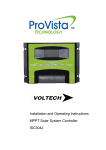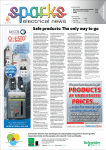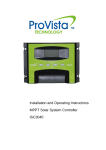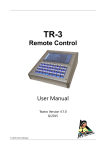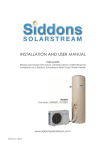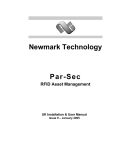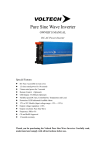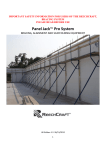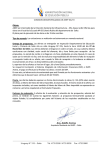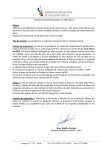Download Installation and Operating Instructions Solar System Controller
Transcript
Installation and Operating Instructions Solar System Controller ISC3032 ABOUT THIS MANUAL These operating instructions come with the product and should be kept with it as a reference to all user’s of the product. Read these operating instructions carefully before use, Keep them over the entire life of the product, And pass then on to any future owner or user of this product. This manual describes the installation, function, operation and maintenance of the solar system controller ISC3032. These operating instructions are intended for end customers. A technical expert must be consulted in cases of uncertainty. SAFETY 1. The solar controller may only be used in PV systems for charging Lead-Acid type batteries. This includes: SLA, VRLA, Lead-Calcium, AGM and GEL. Note; User’s should always refer to battery manufacturer/supplier’s recommended values for battery charging settings and float voltage setting. 2. No energy source other than a solar panel (PV) may be connected to the solar charge controller. 3. Do not connect any defective or damaged measuring equipment. 4. Follow the general and national safety and accident prevention regulation. 5. Never alter or remove the factory plates and identification labels. 6. Keep children away from PV & Battery systems. 7. Never open the device. (No user serviceable parts inside) 8. One set solar module can connect with one controller only. 9. Never touch bare cables. OTHER RISKS Danger of fire and explosion Do not use the solar charge controller in dusty environments, in the vicinity of solvents or where inflammable gases and vapors can occur. No open fires, flames or sparks in the vicinity of the batteries. Ensure that the room is adequately ventilated. Check the charging process regularly. Follow the charging instructions of the battery manufacturer. Battery acid Acid splashes on skin or clothing should be immediately treated with soap suds and rinsed with plenty of water. If acid splashes into the eyes, immediately rinse with plenty of water. Seek medical advice. 2 Fault behavior Operating the solar charge controller is dangerous in the following situations: The solar charge controller does not appear to function at all. The solar charge controller or connected cables are visibly damaged. Emission of smoke or fluid penetration. When parts are loose. If any of these occur, immediately disconnect the solar charge controller from the solar panels and battery. Function This solar system controller is designed to Monitor the state of charge of the battery; Controls the charging process, Control the connection/disconnection of loads, Make sure Solar system works at proper condition. Features Charging Voltage is user programmable. Load Terminal switches Positive side. Manual load switch with automatic re-start. Night-Light Functions Set the two timer schedule programmable for street light application OPERATING THE CONTROLLER The display shows a variety of system data by symbols and digits. Both buttons control all settings and display windows. 1. Display and operation elements. LCD display for controller information and messages. Pagedown button Manual load switch, or confirmation button in program mode (Enter button) Pageup button Button for switching display windows or calling up the settings (Menu button) 3 2. Display window. Change the display windows with the “Menu” button; (e.g. for 12V battery) 1. The default window will show like below, battery voltage/capacity volume of the battery. 2. Press “menu” button once to check charging current. 3. Press” menu” button again to display the load current. 4. When the charging current or output current is less than 0.5Amp, the LCD will always show Min A. When there is no current, it will show 0 Amp. CHARGING CURRENT (<0.5A) OUTPUT CURRENT (<0.5A) 4 5. If solar module cannot provide current or the current is less than 1Amp for 5 minutes, the controller will switch to Night mode and display in the lower right hand corner. 6. When the unit is in the default display mode, Pressing the ‘enter’ button will turn the load ON or OFF manually. The arrow/lamp symbol will be displayed when the load terminal is ON. 3. How to set the system time. 1. At default display mode, press “menu” button 3 times to show controller’s system time to you. In this mode, press “enter” button once, the ‘hours’ will flash, you can adjust the figure via Pageup / Pagedown button, press “enter” button one more time to confirm the setup for ‘Hour’ and switch to ‘Minute’ setup mode, you can adjust the figure of minute via Page up/Page down button, once it’s done, press “enter’ button to save. 2. Charging Voltage Check & Program Press “menu” button 4 times. Window will switch to show BULK voltage setting. To change this setting; Press “enter” button once, you can program charge voltage via Pageup/Pagedown button: 12V Battery (13.8V-14.8V); 24V Battery (27.6V-29.6V) Press “enter” or “menu” button to save setting. 3. Press “menu” button 5 times. Window will switch to show FLOAT voltage setting. To change this setting; Press “enter” button once; you can program Float voltage via Pageup/Pagedown button: 12V Battery (13.0V-14.2V); 24V Battery (26.0V-28.4V) Press “enter” or “menu” button to save setting. 4. You can set the FLOAT Voltage to automatically adjust (trim) voltage, based on the ambient temperature: In the FLOAT setup interface press “enter” button once; use the Pagedown button until LCD displays “OFF”. Float voltage will vary accordingly to the ambient temperatures stated below: 12V system: 24V system: ≤ 0°C. (14.2-14.4v), 0°C - 20°C (13.8-14.4v), ≥20°C (13.5-14.4v) ≤ 0°C. (28.4-28.8v), 0°C - 20°C (27.8-28.8v), ≥20°C (26.9-28.8v) 5 4. Night-Light Function (NLF) setup. Press “menu” button 6 times. Window will switch to NLF setup interface. Press “enter” button once, through Pageup/Pagedown buttons, choose “ON” and then confirm by “enter” button. After NLF on, press “menu” button, window switch to Timer1 setup interface. Press “enter” button once, you can adjust the “Hour” (1-12hours) via “Pageup/Pagedown” buttons, and then confirm it by pressing “enter”. Timer1 hours stands for the time the load terminal will be switched ON. Press”menu” button again, window switch to Timer2 setup interface. Press “enter” button once, you can adjust the “Hour” (1-12hours) via “Page up/Page down” buttons, and then confirm it by pressing "enter”. Timer2 hours stands for the time the load will be OFF after Timer1 hours have finished. NOTE: When the Timer2 hours are finished, the load will turn ON again until dawn. (See Diagram below) If you want the load to stay OFF for the remainder of the night, make sure Timer2 hours are sufficient to reach dawn. The ISC3032 recognizes day and night based on the solar array voltage, NLF (Night mode) will start when the PV Input Voltage falls below 10 Volts (20V/24V Sys). . Standard Controller Mode = NLF set to OFF, (See Item # 9.1 Page 7) 6 5. Timer1 and Timer2 setup. To change Timer settings you must first make sure that NLF is set to “OFF” 9.1. Check that NLF (Night light function) is set to “OFF” by pressing the menu (page) button 6 times from the main default screen. Window will switch to NLF setup interface. Press the “enter” button once, through Pageup/Pagedown buttons, choose “OFF” and then confirm by “enter” button. 9.2 From the main default screen press the menu button 7 times, Timer1 screen will appear. 9.3 Press the “enter” button once. Then adjust ‘Hour’ via ‘Pageup/Pagedown’ buttons. Press the ‘enter’ button to confirm the hour setting and switch to ‘Minute’ adjustment. Use ‘Pageup/Pagedown’ buttons to adjust Minute. Press ‘enter’ button to confirm minute setting. Now using ‘Pageup/Pagedown’ buttons; choose ‘ON’ or ‘OFF’ or ‘ON/OFF’ and then confirm by ‘enter’ button. ‘ON’ stands for the time when you want to turn the load on. ‘OFF’ stands for the time when you want to turn the load off. ‘ON/OFF’ means the Timer is disabled. 9.4 From the main default screen press the menu button 8 times, Timer2 screen will appear. Follow Step 9.3 operation as per above. Timer1 and Timer2 setup should now be complete; you can confirm these settings by using the menu key to scroll through to Timer1 and Timer2 screens FEATURES 1. PWM Charge control Depending on the actual battery level, various charging procedures, float charging and boost charging are automatically performed. The final charging voltage (Float) is also temperature compensated. 2. Deep discharging protection If the battery falls below a specified voltage (11.5V/23V), the load output is disconnected preventing excessive discharge of the battery. Once the voltage increases to 12.5V/25V the load will be automatically reconnected. The set points of the deep discharging protection are predefined and cannot be reset. 3. Two timers can be set to turn the loads on and off automatically. 4. Temperature Compensation ISC3032 has an internal ambient temperature sensor that compensates during the float mode.This functions only when float voltage setup is set to “OFF” (See item no. 4 page 5) 7 INSTALLATION • • • • • • • • • • Install the controller in a ventilated area away from flammable materials and gases. The surface should be solid, even, dry and nonflammable. The battery to controller cable should be as short as possible (1-2mtrs is ideal) and be of a suitable diameter to minimize voltage loss. Do not assemble outdoor, the unit should be installed in the way to be protected against humidity, dripping, rainwater as well as direct and indirect heat (sunlight). To ensure the air circulation for cooling an area of 15cm on each side of the unit must be kept free. The LCD display should be protected against UV rays (e.g. sunlight). Long time exposure to UV rays can permanently discolor the LCD. The solar charge controller may only be connected to the local loads and the battery by trained personnel and in accordance with any applicable regulations. Follow the installation and operating instructions for all components of the PV system. Ensure that no cables are damaged. Ensure that polarity of Solar panel/battery/load is correct and use only insulated tools. WARNING ISC3032 can work with input voltage up to 45 Vdc maximum; when installing at this voltage, particularly with regard to module open circuit voltage (Voc), the entire solar energy system must be installed with protection class II. Cover solar modules during installation and use only insulated tools. CONNECTING / DIS-CONECTING SYSTEM SEQUENCE Connect the wires in the sequence from 1 to 6 according the above diagram; when Disconnect the wires in the REVERSE sequence from 6 to 1 according the above diagram. Use with 12V or 24V battery bank, (controller will detect voltage of battery automatically). Never exceed the nominal ratings (see below technical data for reference). Suggested cable length, 10m solar panel connection cable/2m battery connection cable/5m load connection cable. TECHNICAL INFORMATION Max. Input Current 30A DC Max. Input Open Circuit Voltage (Voc) 45V DC Max. Load Current 30A DC Adjustable Charge Voltage(Bulk) 13.8-14.8V / 27.6-29.6 V DC Adjustable Charge Voltage(Float) 13.0-14.2V / 26.0V-28.4V DC Low Voltage Disconnect 11.5V / 23.0V DC ± 2% Auto Reconnect Voltage 12.5V / 25.0V DC Output Voltage 12 / 24V DC Typical Idle Consumption <20mA DC Operating temperature -20 °C/ +50 °C 8 CHARGING CURVE Bulk: This is the first stage where the battery is in a low charge state (typically 10%), & receives the majority of its charge. During this stage the battery is brought to about 95% of its charge by getting 100% of the available solar power. Float (Pulse mode, Maintenance): At the end of bulk stage, typically when the battery reaches 14.4 Volts, a maintenance mode starts where the battery voltage can float between an high and low value fixed by the controller. These values are temperature compensated in order to keep the battery at 100% charge stage in any condition. PROTECTION FUNCTIONS Overcharge protection Deep discharge protection Battery under-voltage protection Solar panel reverse current protection The following installation faults do not destroy the controller. After correcting the fault, the device will continue to operate correctly: Overcharge protection Deep discharge protection Reverse polarity protection of load, panel and battery Automatic electronic fuse Short circuit protection of load and panel Over voltage protection at panel input Open circuit protection without battery Reverse current protection at night Overload protection Battery over voltage shutdown GROUNDING Grounding ISC3032 is not technically required when installing a stand alone solar system. However, if required, Common grounding of the negative Battery and Load control output is OK (for negative earth electrical systems such as a caravan or motor-home). Caution: ISC3032 can ground the negative only, and PV array is not allowed to have negative grounding. MAINTANANCE The controller is maintenance-free. We strong suggest that all components of the PV system must be checked at least annually, Ensure adequate ventilation of the cooling element Check the cable strain relief Check that all cable connections are secure Tighten screws if necessary Terminal corrosion 9 ERROR MESSAGES Caution! Please do not open the controller or attempt to replace components when troubleshooting. Improper maintenance can be hazardous to the user and the system. If the controller detects errors or unauthorized operating states, it shows error codes on the display. Error codes can generally be differentiated, whether there is a temporary malfunction, e.g. regulator overload or a more serious system error that can be remedied by appropriate external measures. Since not all errors can be simultaneously displayed, the error with the highest error number (priority) is displayed. If several errors are present, the second error code is displayed after remedying the more significant error. The following meaning is assigned to the different error codes: 1. Meaning: Battery reverse polarity warning Remedy: Reconnect battery correctly. 2. Meaning: Battery Voltage (Too high or too low) Remedy: Check battery voltage it might be too low or too high, possible recharge battery manually. If battery can’t be recharged, Replace battery & re-check. 3. Meaning: Module current too high. Remedy: Reduce the input current (module power) to <30Amps. 4. Meaning: Over current at the load output. Remedy: 1) Reduce load current to <30Amps.. 2) If reducing load current does not work; Press “Enter” button. If LCD shows E4 with NO load connected or, LCD shows current as 0.00A. WITH a load of more than 50Watts running, Then follow the Reset Procedure as follows; 3) Reset: Dis-connect the unit by removing all connections in Reverse sequence from 6 to 1 (see Page 8), then follow the reset procedure: i. While holding down the “Menu” button, re-connect the Battery terminals to the unit. ii. Release the “Menu” button, this will prompt the LCD to show “FFFF” iii. First connect the PV then the Load terminals NOTE: Always connect the Negative first, then the Positive for all connections 10 5. Meaning: Solar Module reverse polarity warning Remedy: Reconnect solar module correctly E5 could also mean: not enough sunlight to charge the battery. 11 The Leading Edge in Solar Technology Waste electrical products should not be disposed of with household waste Please recycle where facilities exist Check with your local authority or retailer for recycling advice Specifications are subject to change without prior notice Copyright reserved by ProVista Technology Limited Instruction manual Ver. 2.0 : FOR TECHNICAL ADVICE OR HELP PLEASE CONTACT: PH: 07 3219 6655 FAX: 07 3219 6644 EMAIL:[email protected] WEB: www.electroparts.com.au 12













